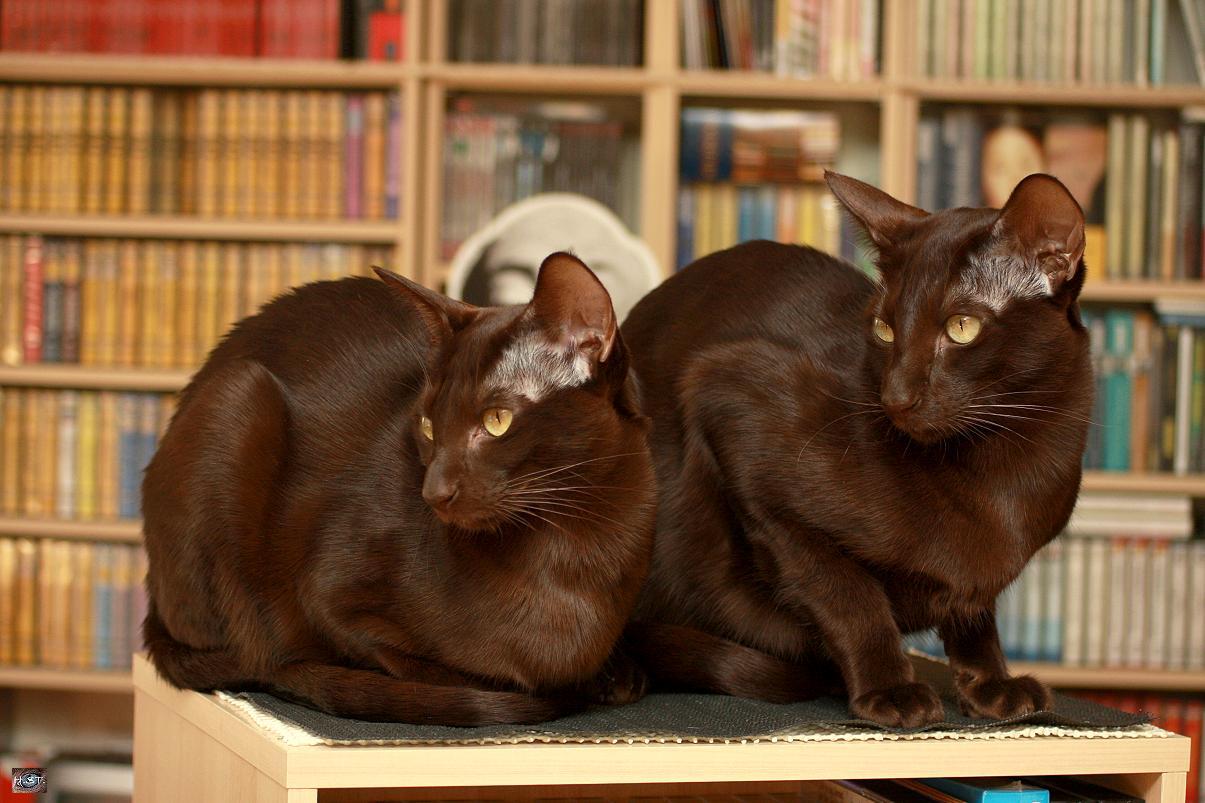Content |
|---|
Characteristics "Havana brown cat"
Coexistence is important that you have with your new friend. Before considering the acquisition of a cat of the breed "Havana brown cat" you know certain factors. You must take into account their character, their need for exercise, their interaction with other pets, their care and if you have small children, their level of tolerance towards them.
Joy4.0 out of 5 stars (based on 1 review)
|
Activity level3.0 out of 5 stars (based on 1 review)
|
Friendliness to other pets3.0 out of 5 stars (based on 1 review)
|
|---|---|---|
Friendliness to children3.0 out of 5 stars (based on 1 review)
|
Grooming requirements1.0 out of 5 stars (based on 1 review)
|
Vocality1.0 out of 5 stars (based on 1 review)
|
Need for attention5.0 out of 5 stars (based on 1 review)
|
Affection towards its owners4.0 out of 5 stars (based on 1 review)
|
Docility3.0 out of 5 stars (based on 1 review)
|
Intelligence5.0 out of 5 stars (based on 1 review)
|
Independence2.0 out of 5 stars (based on 1 review)
|
Hardiness3.0 out of 5 stars (based on 1 review)
|
History
The Havana brown He is a descendant of the famous Siamese. Its origins date back to the fourteenth century in the Kingdom of Siam, current Thailand. The brown cats were described and represented together with the Siamese and the Korat cat in numerous manuscripts of poems and paintings found in the city of Ayutthaya, which was then the capital of the kingdom. They were considered very beautiful, but above all, good luck charms for their owners.
These chocolate-colored felines were among the first to be imported from Siam to the UK, where they arrived at the end of the 19th century. The texts of this time, like the writings of an English breeder named Madame French and passages from Frances Simpson's book of 1903 The Cat Book, describe a Siamese cat with brown fur and blue-green eyes.
It is probable that not all imported cats of this color were of the same breed and that among them there were burmese, Siamese and the Tonkinese cat (a cruce enters Burmese and Siamese). But, it is difficult to differentiate the breeds from the available writings and drawings.
In any case, It was at this time that the term was coined “swiss mountain cats” to designate cats with this particularity. But, historians cannot establish whether it covered all chocolate-colored specimens imported from Thailand in the late 19th century, or only those of one or more specific races.
Brown cats were exhibited in Europe in the late 19th and early 20th centuries. At an exhibition held in England in 1888, one of them won the first prize, which tends to show that felines of this type enjoyed a certain visibility and popularity at the time. This is corroborated by the fact that in 1928, in another exhibition held in Great Britain, the British Siamese Cat Club went on to award a special prize to the chocolate-colored specimens.
Just two years later, in 1930, god a ride, promoting only the breeding of cats Siamese blue-eyed. But, a large majority of brown individuals had green eyes and not blue, so they were suddenly excluded from competitions organized under the aegis of the organization. Logically, breeders began to abandon this color, and the number of individuals wearing it drastically decreased.
This decline continued until the years 50, when a group of British breeders, among which were Baroness Miranda Von Ullman and Anne Hargreaves, they set out to give these cats a new life. They studied the inheritance of the chocolate gene and launched a breeding program based on their research.. New crosses were made between Siamese chocolate-colored, domestic cats blacks and the Russian Blue Cat, which resulted in the tan brown as we know it today. The first kitten regarded as a Havana brown was born in the UK in 1952 and it was called Elmtower Bronze Idol. Result of a cross between a Siamese cat seal point carrier of the chocolate gene and a black cat also carrier of the gene, became one of the founders of the breed.
The main British feline organism, the Governing Council of the Cat Fancy (GCCF), recognized the new breed in 1958 as Chestnut Brown Foreign. Twelve years later, in 1970, was replaced by the Havana brown. There are two opposing hypotheses to explain the choice of this name: the first is that it refers to its brown color similar to tobacco, while the other claims that it comes from a breed of rabbit of the same color called Havana.
Even before its official recognition in Great Britain, the breed had taken its first steps in the United States. In fact, after coming into contact with Mrs.. From Ullman, an American breeder named Elsie Quinn imported two cats into 1956. A selection process was started somewhat different from that of the United Kingdom, so soon the American and English types were differentiated. This is still the case today, the first being more massive than the second, whose morphology is long and thin, apparently modeled on that of the Siamese.
The Cat Fanciers’ Association (CFA) accepted the breed in 1964, and The International Cat Association (TICA) did the same in 1979. Both took the North American version of the breed as a reference., whose features differed significantly from the British model recognized by the GCCF: the latter had a longer and thinner oriental morphology. Despite this formalization of the existence of two very different types of cats, the name remained the same for all bodies: Havana brown. In 1983, the TICA accepted the lilac color in its standard, whereas until then only the color chocolate was allowed. Quite consistently, decided at the same time to change the name with which he recognizes the breed, in favor of him Havana. In France, the Livre Officiel des Origines Félines (LOOF) did the same and began to accept the lilac color, but kept the denomination Havana brown.
In United States, the beginning of the years 90 was characterized by the loss of interest in breeding this breed, whose number dropped a lot. The breed became especially rare and, at the end of the decade, the CFA only had 12 hatcheries and some 130 representatives of the breed throughout the country.
The situation worried some breeders, who feared that the cats would disappear. They contacted Dr.. Leslie Lyons, who was then working at the California Veterinary Genetics Laboratory, so that with your help they could develop a breeding program. The analyzes of the genome of the Havana brown revealed excessive inbreeding. In other words, a healthy development of the breed was only possible if new individuals were introduced in the breeding programs.
Thus, the breeders asked the CFA to open the breed to new crosses, what was accepted by the organization in 1997. Since that year, it has been possible to cross the brown Havana with siamese cats Seal Point and Chocolate Point, Oriental Longhair cat, as well as with domestic cats blacks and blues not beggars in the United States. If the individuals born from these crosses are brown, are recognized by the CFA as Havana brown. On the other hand, regardless of its color, if they cross paths with the Havana brown, their offspring is considered by the organization as Havana brown.
This show turned out to be a success: expanded the breed's gene pool and kept it healthy, at the same time that it allowed to continue increasing the number of dogs in the country. These authorizations are still valid today., but they are still exclusive to the United States, since organizations from other countries do not allow these crossings.
But, the surge in popularity was short-lived, and the Havana brown is now at the bottom of the CFA's annual enrollment rankings, in the post 42 of 45 in 2018, after falling steadily in previous years. These may include, early in the decade 2010, rather occupied the position 30 or 35.
But, the problem of the lack of diversity in the different lines also arose in other places, like the UK. During the decade of the 90, some changes in the selection of Havana brown and the Siamese modified the quality of the fur of the latter and other morphological parameters, what some people did not like.
In 1996, a breeder named Joan Judd expressed concern about the future of the breed, What, in addition to these changes away from its original appearance, suffered from a clear lack of representation. He wrote an article explaining, among other things, that the Havana brown couldn't survive without an influx of foreign blood. Under your direction, a small group of breeders, among which were Mrs.. P. Sharp-Popple, la Sra. S. Miller and Linda and Charlie Spendlove, selected some specimens and developed a joint breeding program called Pure Havana. As such, the Sr. and mrs. Spendlove imported a subject from the French breeding of Claire Rassat. Christened St Evroult Gatsby, was initially registered with the GCCF as a Havana brown.
In view of its traditional pattern, breed enthusiasts Havana brown The modern model did not look favorably on the five litters it produced and complained to the GCCF, requesting that St Evroult Gatsby be removed from the breeding program. But, they came across a number of enthusiasts who had noticed the qualities of the traditional model through this small group of cats, and defended him before the association. The GCCF then proposed that these cats form a new breed, which was baptized as Suffolk and officially recognized by the organization in 2014. So, the Suffolk is considered a separate breed from the Havana brown, although it is very similar to him. It can be chocolate or lilac color. 13 Suffolks were registered with the organization in 2018, and 35 in 2019.
In France, the Havana brown is very underrepresented. The number of people registered each year in the LOOF does not exceed fifteen, for a total of 108 between 2010 and 2019.
Worldwide, its total population is estimated to be no more than a thousand, so it is still a rare feline breed.
Physical characteristics
"Havana brown cat" |
||
|---|---|---|
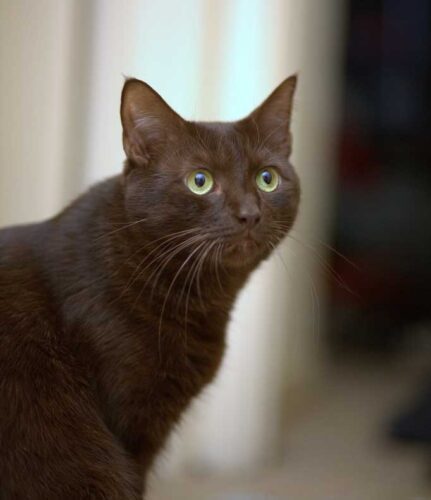 | ||
The Havana brown it is a medium size cat, long-legged, with good muscles and strong bones.
The legs are straight. They are finer and more delicate in females than in males. They also have the most developed muscles, so its slenderness and length are less striking than in the female.
Regardless of gender, the hind legs they are longer than the front ones. The feet they are oval shaped, compact and the pads are pink.
However, keep in mind that there are two versions of the Havana brown: the american and the english. The first is usually more muscular and massive than the second, that preserves the longest and slimmest body of the oriental cats.
In both cases, the tail is fine and of medium length.
The neck It is also medium in size and proportional to the size of the body. View from the top, the head it is longer than it is wide, and ends in a rounded nose with a clear break on either side of it. This is a distinctive trait of the breed, which must be clearly visible. The chin is well developed and square. Ideally, it should form a nearly perpendicular angle to the nose.
The ears they are wide and rounded at the tip. Are leaning forward, which gives the appearance of being always alert.
The eyes they are medium in size and oval in shape, wide apart and bright. They give you an alert and always expressive expression and are necessarily green, accepting all shades of this color.
The fur of the Havana brown it is made up of short hair, smooth and shiny. All shades of brown accepted, but a reddish brown color is generally preferred (Mahogany) to a blackish brown color. Some organizations, like LOOF and TICA, they also accept lilac, But not all. Whatever the color of the cat's coat, should be uniform throughout your body. Kittens can be born with tabby markings, but these normally disappear as they grow.
The whiskers they are also brown.
Last, the sexual dimorphism it is quite marked, being the male heavier than the female, although its size is quite similar.
Size and weight-
- Male size: Of 25-30 cm.
- female size: 25-30 cm.
- Male weight: 3,5-4,5 kg
- female weight: 2,5-3,5 kg
Varieties of "Havana brown cat"
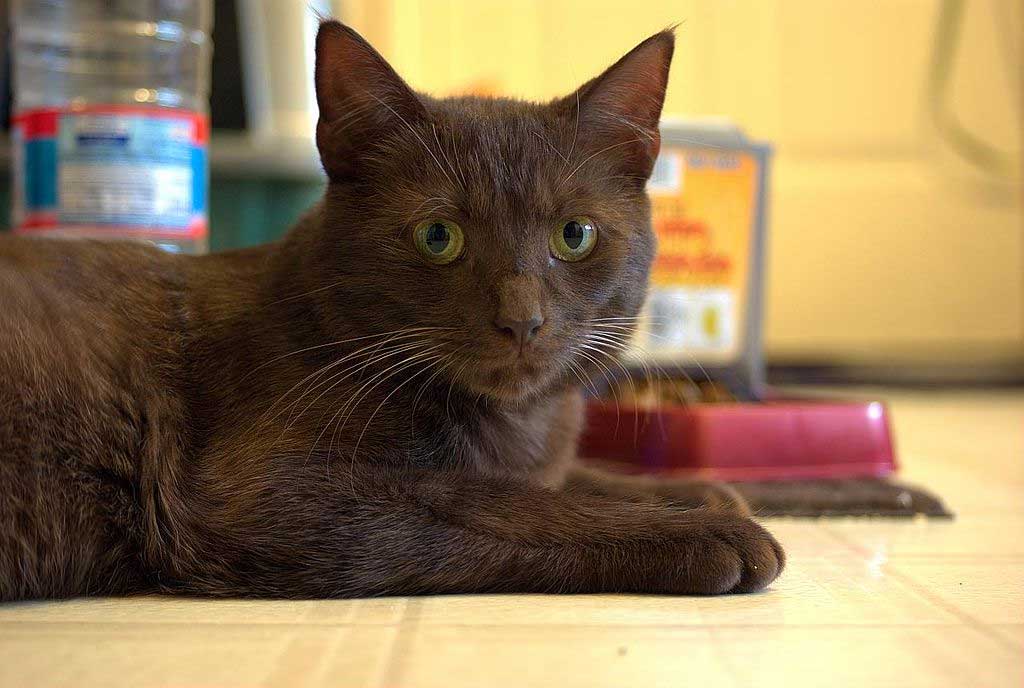
The former has a very long morphology and is close to its cousins and ancestors from the East, especially the Siamese. It is a very fine and muscular cat.
As for him Havana brown American, it is more solid and round, deviating from the elongated morphology to sometimes approach the semi-free type. Although more rectangular and strong, it is no less elegant.
Another example is the Suffolk, created in the early 21st century by British enthusiasts of the Havana brown who opposed the evolution that the race was experiencing in their country. The Suffolk it's a kind of Havana brown traditional, as opposed to the modern version that is now in the country. The GCCF recognized his work in 2014, recognizing it as a breed in its own right.
Character and skills
The Havana brown he is an affectionate cat, friendly and intelligent. It also, unlike its ancestor the Siamese, it is quite calm and serene.
He is also more adaptable than most of his peers., since it is not one of those who are scared by a change of environment, for example. This flexibility makes it a good option for someone who wants to take their cat on vacation or is moving frequently., for example.
To be happy and at ease, this constantly seeking attention-loving companion needs a lot of interaction with humans. He likes to follow his master around the house and accompany him in housework. So, needs an owner who is present often and who does not fail to show him that he loves him every day. This makes it a very good cat breed choice for an older person., and a very bad one for an active person who spends most of his time away from home.
Very tactile, does not shy away from contact with its owner. On the other hand, you like to physically interact with him, with a marked tendency to touch him stretching the leg to attract his attention. He also uses his paw a lot to examine things that are interesting to him.
These qualities make it an ideal cat for children., especially since he never tires of playing for hours.
On the other hand, can be exclusive, as close to its owners as it is shy and distant with strangers, at least at the beginning.
Usually, they get along very well with other animals, including dogs, provided they are gradually introduced or, even better, from an early age. But, it is advisable to take some precautions if you are brought to live with rodents, birds or fish, since the Havana brown is a great player and his ability to find in any object -or small animal- an exciting toy is awesome. Be careful to store her socks and other small items that are easy to transport, or you may not see them again. Having said that, the games he likes the most are those that involve interaction with their owner. It is an excellent candidate to teach your cat tricks, and also excels at solving puzzles.
Last, if he is not as talkative as the Siamese, nevertheless likes to chat with its owners through soft meows.
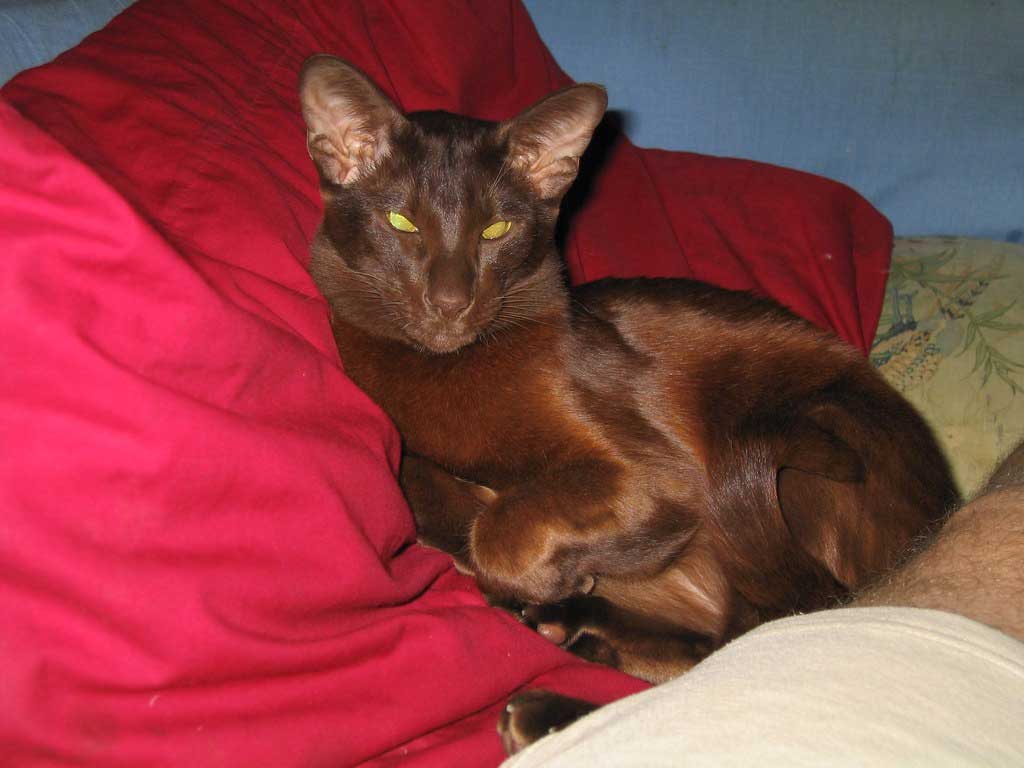
Grooming and caring for the "Havana brown cat"
The Havana brown it is an easy-care cat.
Needs weekly brushing but sheds very little, except during the shedding season in spring and fall, when more frequent brushing is necessary - often daily- to prevent hair from accumulating in the house. Finishing brushing with a felt or hand cloth helps remove dead hair that has resisted brushing. Bathing is seldom necessary.
Ears and eyes should also be checked regularly, ideally once a week, to avoid infections, and get cleaned up as soon as needed.
Your weekly maintenance session is also an opportunity to brush your cat's teeth., in order to avoid the formation of tartar and all the risks that it entails. Having said that, the ideal is a more regular brushing.
Last, Since the Havana brown he does not usually go abroad much -if he does-, the natural wear of its claws is usually insufficient. So, they need to be examined regularly to trim them when they get too long, in order to prevent them from being hindered in their movements and / or injuring themselves. It is highly recommended that you provide him with a scratching post so that he can wear them down himself and don't have to do it as often.
If your pet is used to being handled from a young age, will perfectly accept these different treatments.
Indoor or outdoor cat?
He loves to play and run around the house and spends a lot of time, but it is a perfect indoor cat, fully satisfied with a life in a flat, as long as their owners are present and they have enough games to keep busy. Even if I have access to the outside, it's not where you like to spend most of your time. So, you don't need a garden to adopt a cigar, that is something sensitive to cold.
How much activity does he need? "Havana brown cat"?
The Havana brown they are not sleepy. You should offer your roommate some job opportunities. This is important to this intelligent breed when you are away.. This domestic cat loves to play with his human. Learning little tricks is not a problem. This need for activity can be exhausting after a day at work.. An alternative would be a cat companion of the same age and temperament as a balance.
Health and nutrition
"Havana brown cat" |
||
|---|---|---|
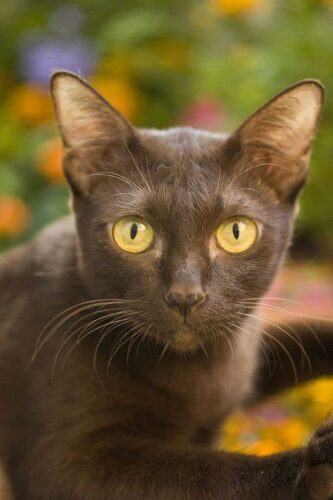 | ||
The Havana brown enjoys, in general, Of good health.
But, may be prone to developing calcium oxylate stones in the urinary tract. If it is not attended on time, can lead to blockage of the cat's urinary tract. Cats prone to this problem should drink plenty of water to avoid stone formation as much as possible.
Some cats can also suffer from upper respiratory tract infections, that is to say, those that affect the nose, sinuses, pharynx and larynx, When you are young. Among them is chlamydia, for which there is a vaccine, which can be a smart investment to maximize the chances of keeping your cat healthy. In general, the general symptoms of a respiratory infection are fever, sneezing, tos, watery eyes or a runny nose.
Last, the Havana brown is sensitive to cold. In any case, it is not an outdoor cat, but it is important to ensure that it does not come out when the temperatures are very low.
Life expectancy
15 years
Food
A quality industrial cat food is perfectly suitable for the Havana brown, that is not a demanding cat. As with any cat, you simply have to adapt the daily ration to your level of physical activity and your age.
In any case, not the type of cat who likes to eat too much: is a teether and very rarely suffers from obesity. Once you've made sure your cat is no exception that proves the rule, food can be left at your disposal at all times without risking health problems, since it is capable of self-regulation.
On the other hand, an individual prone to urinary stone problems should be encouraged to drink heavily. As in the case of any cat, fresh water must be available at all times, but the owner can add some milk, tuna juice or ice cubes to the water bowl to encourage the cat to drink more.
For sale "Havana brown cat"
In Europe, the price of a kitten Havana brown usually oscillates between 900 and 1100 EUR. The price difference between male and female cats is quite small, normally it does not exceed one hundred euros.
In North America, the price range is much wider, oscillating between 600 and 1.500 $.
whatever the country, the main parameters that affect the price are its greater or lesser conformity with the breed standard, the reputation of the cattery and the origins of the kitten. Another important factor is color: a Havana brown reddish, for example, is more prized than a blackish brown specimen and, Therefore, likely to sell at a higher price.
In any case, what is rare is usually expensive, and this cat is no exception. There are few hatcheries of Havana brown in North America, and even less in Europe. So, it can be quite difficult for a future owner to find their rare gem.
Videos "Havana brown cat"
|
TOP 10 HAVANA BROWN CATS BREEDS
|
Coco Chanel – Chocolate Cat – Havana Brown
|
|---|
